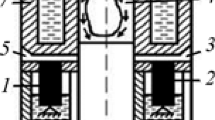Abstract
Extensive use of die casting is limited by the short operating life of molds with cyclically changing temperature and stresses. As a result of this action there is thermal fatigue failure of the operating surface layer of a mold. This article considers features of the thermal fatigue failure mechanism for steels 3Kh2V8F and 4Kh5MFS used for mold manufacture.
Similar content being viewed by others
References
S. S. Gorelik, L. K. Rastorguev, and Yu. A. Skakov, X-Ray and Electron Optical Analysis [in Russian], Metallurgiya, Moscow (1970).
L. S. Kremnev and A. Ya. Zabezhinksii, “Development and selection of heat-resistant tool steels for water-cooled dies,” Metalloved. Term. Obrab. Met., No. 2, 25–29 (1980).
Yu. A. Geller, Tool Steels [in Russian], Mashinostroenie, Moscow (1983).
A. Hudremont, Special Steels, Vol. 11 [Russian translation], Metallurgiya, Moscow (1966).
M. I. Gol'dshtein, S. V. Grachev, and Yu. G. Veksler, Special Steels [in Russian], Metallurgiya, Moscow (1985).
P. L. Gruzin and V. V. Mural', “Mechanism of the effect of molybdenum on reversible temper brittleness of steel,” Metalloved. Term. Obrab. Met., No. 3, 70–74 (1969).
B. F. Trakhtenberg and M. A. Shubina, “Structure of white layers formed with cyclic temperature an force effects,” Metalloved. Term. Obrab. Met., No. 3, 56–57 (1969).
R. R. Faskhutdinov, B. N. Zhuravlev, and O. I. Nikolaeva, “Use of corrosion-resistant steels for molds,” Metalloved. Term. Obrab. Met., No. 4, 2–8 (1986).
L. Z. Rumshiskii, Mathematical Treatment of experimental Results: Reference Manual [in Russian], Nauka, Moscow (1981).
D. Broek, Bases of Fracture Mechanics [Russian translation], Vysshaya Shkola, Moscow (1980).
T. Ekobori, Physics and Fracture Mechanics and the Strength of Solids [Russian translation], Metallurgiya, Moscow (1971).
S. Taira and R. Otani, Theory of High-Temperature Strength of Metals [Russian translation], Metallurgiya, Moscow (1986).
I. I. Goryunov, Molds for Die Casting: Reference Manual [in Russian], Mashinostroenie, Leningrad (1973).
L. F. Kratovich and G. D. Tkachevskaya, “Structural factors in the fracture toughness of die steels,” Metalloved. Term. Obrab. Met., No. 7, 23–26 (1988).
Additional information
Rybinsk Aviation Technology Institute. Translated from Metailovedenie i Termicheskaya Obrabotka Metallov, No. 4, pp. 34–37, April, 1994.
Rights and permissions
About this article
Cite this article
Zhukov, A.A., Postnova, A.D. & Ryabov, Y.V. Features of thermal fatigue failure for die steels 3Kh2V8F and 4Kh5MFS under injection mold operating conditions. Met Sci Heat Treat 36, 224–229 (1994). https://doi.org/10.1007/BF01400807
Issue Date:
DOI: https://doi.org/10.1007/BF01400807




